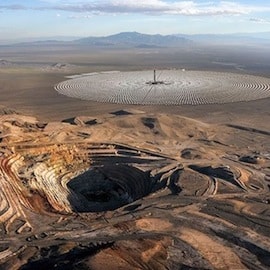Making a Successful Business Pivot During the Energy Transition: Three Lessons from an Auto Supplier Diversifying into Renewables
Efforts to decarbonize the world’s energy systems are accelerating, pushing many industries and companies to innovate to survive. But while this global energy transition brings profound change — and with it new challenges — it also heralds tremendous opportunity in new areas.
The automotive industry is a highly visible proving ground for this shift, as the transition to electric vehicles (EVs) gains momentum around the world. We at the William Davidson Institute at the University of Michigan (WDI) are examining the drivers and implications of this shift: For instance, increasingly stringent emissions standards — along with government and company targets and commitments to phase out the production of internal combustion engine (ICE) vehicles — often mean that established companies along the ICE value chain have to reimagine their role in this changing landscape to stay competitive.
As part of our efforts to support business development in low- and middle-income countries (LMICs), WDI is studying how companies in these markets (and others) are navigating the energy transition. In Mexico, for example, we have examined the potential impact of electrification on automotive suppliers in the state of Chihuahua, highlighting new opportunities in the EV space that companies could consider. More broadly, we’re contributing to analysis and conducting research on the business pivots that companies are making as a result of this transition, and we’re seeking to disseminate knowledge around these examples for the benefit of the broader sector.
One such company is Bosal, a global Tier 1 automotive supplier — i.e., one that provides products directly to automotive original equipment manufacturers (OEMs). The company is in the process of leveraging its expertise with ICE-related products to expand into the renewable energy market, before the predicted dwindling of its ICE portfolio. In this article we describe some strategies and lessons from Bosal’s evolution that can be valuable to other companies affected by the energy transition. The insights we include here are based on interviews with Bosal’s Executive Vice President for Energy, Cedric Ballarin.
Bosal: from emissions control systems to hydrogen
Bosal is primarily known as a manufacturer of emissions control systems (including exhaust systems, catalytic converters, heat exchangers, particle filters, etc.) focused on the business-to-business market. Founded in 1923 and headquartered in the Netherlands, it’s a family-owned company with a global footprint that includes 16 manufacturing and distribution centers and six R&D centers in countries around the world. Its customers have historically been automotive OEMs, and its presence in LMICs extends from Mexico and Brazil, to South Africa and Turkey.
In response to the energy transition and changing market needs, Bosal has been working on refocusing its product portfolio to serve the needs of customers outside the traditional automotive industry. As is the case for many automotive suppliers, the company has found that the pie is getting smaller when it comes to future potential revenue from ICE-specific products such as catalytic converters and exhaust systems. This has created an increasingly urgent need to diversify away from these products, as the OEMs that comprise the customer base for Tier 1 suppliers double down on electrification investments that reduce their need for ICE-related products like Bosal’s. With global investments in renewable energy and energy efficiency technologies reaching an all-time high of US $1.3 trillion in 2022, up 19% from 2021 investment levels, the trendline suggests that demand for products related to renewable energy applications will continue to grow.
One high-potential area Bosal has identified is hydrogen production, with global investments signaling growing interest in hydrogen-related applications. Indeed, despite the ongoing debate about the feasibility and efficiency of a hydrogen value chain, many believe that clean hydrogen has a critical role to play in a net-zero emissions world, especially in hard-to-decarbonize sectors such as steel making, chemicals manufacturing and heavy-duty transport.
Satisfying greater demand for clean hydrogen will require scaling up production and reducing the cost of electrolyzers (which produce hydrogen by using electricity to split water into hydrogen and oxygen) and fuel cells (which convert hydrogen into electricity) — as well as the components needed to make these technologies operate as efficiently as possible. To that end, heat exchangers are critical components of certain types of electrolyzers and fuel cells, such as those that use solid oxide technology, which generate heat as a by-product. Heat exchangers manage the temperature changes involved in these complex processes and can improve the performance, efficiency and lifespan of these technologies.
Bosal already specializes in designing and manufacturing high-performing heat exchangers, which are used in its emissions control systems. It has now enhanced these devices to enable their use in solid oxide fuel cells and solid oxide electrolyzers, two of the several types of fuel cell and electrolyzer technologies currently available. Recognizing an opportunity here, the company is ramping up the development of these heat exchangers, which can also be used in a variety of stationary applications beyond the mobility market.
Bosal’s recently created energy division is key to these efforts, as part of its broader goals of implementing innovations to suit the needs of a wide range of new customers, finding new markets, and helping the company capitalize on its automotive roots to manage its transformation in the emerging renewable energy space.
So what does it take for an automotive supplier to transform into an energy solutions company?
Enabling the pivot: practical lessons
Here are three lessons that we can distill from Bosal’s ongoing efforts to execute this pivot into a new market and tap into new opportunities — while also addressing the inevitable growing pains:
- Combine realism with ambition
For Bosal, being realistic about its business model has meant closely monitoring the momentum building around decarbonization, recognizing this trend as an existential threat to its traditional business — then taking action. However, the company also recognized that this action does not entail eliminating current products, but rather leveraging its expertise in heat exchangers and related manufacturing processes (e.g., steel, pipes, cooling, bending, cutting, welding, etc.) to develop more advanced products that can be used in new applications. In other words, Bosal realized that to conduct a successful pivot into a different market, it would need to build on its existing technical expertise, established footprint and assets to manufacture high-volume and high-quality products at a competitive cost.
At the same time, the company saw that even with its established assets and expertise, it needed to embrace the changes inherent to diversifying its customers and refining its business model. By staying attuned to the needs of this new market — defined more broadly than automotive — Bosal was able to identify new opportunities and refocus its efforts to take advantage of them. In this case, the need for new energy storage solutions and the potential of hydrogen has allowed it to enter a market that was not on most companies’ radar 10 or 15 years ago.
The global fuel cell market is projected to reach US $ 36.41 billion in 2029, up from US $ 4.58 billion in 2021, and global capacity to manufacture electrolyzers could exceed 60 gigawatts per year by 2030, up from 8 gigawatts per year in 2022. With its new strategy, and given this anticipated market growth, Bosal envisions that in the next five to seven years, its two product lines will intersect: Sales related to heat exchangers for electrolyzers and fuel cells will be on par with (and then overtake) sales of emissions control systems, as revenue from new energy technologies eventually offsets anticipated revenue losses in its ICE-focused line.
- Take risks on products that stand out from the competition
Other auto suppliers are also leveraging their expertise in automotive engineering and manufacturing to develop hydrogen production technologies, as well as fuel cell vehicles and other applications. Product differentiation is therefore key, if a company hopes to stand out amid the competition.
Sometimes this means taking risks. In Bosal’s case, that means betting on solid oxide technology for electrolyzers and fuel cells. Both of these technologies are currently considered niche, and they are earlier in their development than other technologies in terms of their commercial readiness to be incorporated into a global hydrogen market. However, they also have high growth potential for various reasons. For example, solid oxide fuel cells are fuel neutral, and can operate with natural gas, biogas or other fuels — as well as with hydrogen. This enables rapid adoption, since customers can begin by using fuel with existing infrastructure, such as methane gas, and migrate to hydrogen when the necessary infrastructure is in place. Solid oxide also offers higher efficiency rates than some other fuel cell and electrolyzer technologies, producing greater output for the same operating cost.
To further differentiate these new products, Bosal has made their impact on efficiency a core part of the value proposition it communicates to its energy sector customers. This highlights an important difference relative to its automotive portfolio: Whereas Bosal’s heat exchangers for exhaust systems don’t directly influence the efficiency of the engines that utilize them, its new heat exchangers can have a significant impact on the efficiency of fuel cells and electrolyzers, making them highly valuable components. When applied at scale, the impact of this efficiency can be massive. Articulating this benefit is a key part of developing a value proposition that appeals to Bosal’s new customers: The upfront cost of the product is offset by the efficiency gains expected in the overall system — a long-term value that needs to be made clear to the customer.
- Embrace a new paradigm
In doubling down on its energy product line, the company is stepping more decisively into a space that is different from the automotive industry in many ways. For starters, its customers are much more diverse: While in the auto industry a supplier like Bosal may have 12 customers worldwide, in the energy sector there are thousands of potential customers of different types. These can range from small startups and midsize companies to multi-billion dollar conglomerates, and can include energy producers, other automotive suppliers looking to pivot beyond ICE vehicles, energy service providers and oil exploration companies, among others.
This diversity means that customers have vastly different expectations from one another, which requires a completely different approach to customer relationships than the strategies used by companies that serve just one type of customer. In many ways, Bosal has had to forget what it has learned from managing auto customers — an industry with highly standardized processes and specifications, as well as more predictable product cycles — and develop new customer service strategies based on individual expectations and product requirements for a myriad of applications.
It has also needed to prepare to expand further into LMIC markets, as the potential for renewable energy applications grows there. While Bosal’s main markets today are Europe, Asia and North America, many LMICs have developed plans and roadmaps to become hydrogen hubs or otherwise develop capabilities in this space, which will open new opportunities for the company to serve a wide range of potential customers in those markets.
Looking ahead
As Bosal solidifies its new heat exchanger offerings, it is also exploring further avenues to grow its business, either through concentric or vertical diversification. These include, for example, exploring carbon capture and recycling applications for energy-intensive industrial processes.
With new products or applications for different markets in the works, the company is well on its way to transforming itself into an energy solutions provider. As it continues this journey, it will have to adapt to rapidly changing market dynamics and respond to new opportunities. But by anticipating these challenges and laying the groundwork for this future growth, it has greatly enhanced its ability to not only survive the global energy transition today, but to thrive in the renewable energy markets of tomorrow.
Is your company undergoing a transition in the energy or mobility space — or are you involved in research on this topic? If so, please reach out to share your insights or questions.
Diana Páez is Senior Director, Energy & Mobility at the William Davidson Institute (WDI), and Dana Gorodetsky is Program Manager, Energy at WDI.
WDI is NextBillion’s parent organization.
Photo courtesy of Bosal.
- Categories
- Energy, Technology, Transportation




